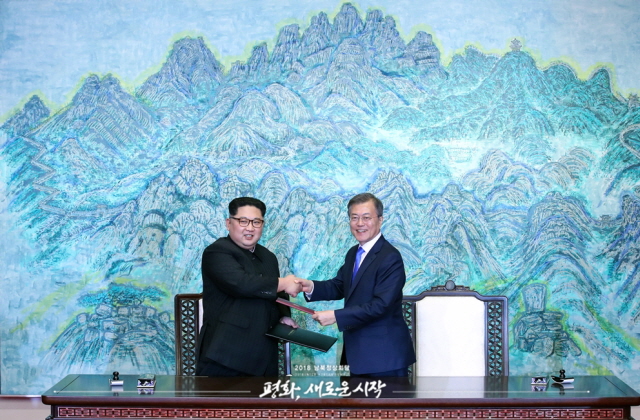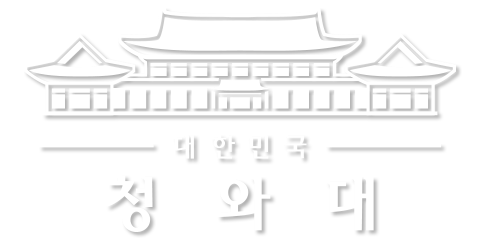이 웹사이트는 제19대 대통령 임기 종료에 따라 대통령기록관이 「대통령기록물 관리에 관한 법률」에 의해 이관받아 서비스하는 대통령기록물입니다. 자료의 열람만 가능하며 수정 · 추가 · 삭제는 불가능합니다.
다만, 「개인정보보호법」에 의하여 개인의 정보를 보호받기 원하시는 분은 관련 내용(요청자, 요청내용, 연락처, 글위치)을 대통령 웹기록물 담당자(044-211-2253)에게 요청해 주시면 신속히 검토하여 조치해 드리겠습니다. 감사합니다.
SPEECHES & REMARKS
BRIEFINGS
Panmunjom Declaration on Peace, Prosperity and Reunification of the Korean Peninsula

(Submitted to the United Nations General Assembly on September 6, 2018)
Panmunjom Declaration on Peace, Prosperity and Reunification of the Korean Peninsula
Kim Jong Un, Chairman of the State Affairs Commission of the Democratic People’s Republic of Korea and Moon Jae-in, President of the Republic of Korea, reflecting the unanimous aspiration of all the Koreans for peace, prosperity and reunification, held the Inter-Korean Summit Meeting at the “Peace House” at Panmunjom on 27 April, 2018 at the significant period of historic turn being made on the Korean peninsula.
The two leaders solemnly declared before the 80 million Koreans and the whole world that there will be no more war and a new era of peace has begun on the Korean peninsula.
They, sharing the firm commitment to bring a swift end to the Cold War relic of longstanding division and confrontation, to boldly open up a new era of national reconciliation, peace and prosperity, and to improve and cultivate interKorean relations in a more active manner, declared at this historic site of Panmunjom as follows:
1. The two sides will reconnect the blood relations of the nation and bring forward the future of co-prosperity and independent reunification led by Koreans by achieving comprehensive and epochal improvement and development in inter-Korean relations.
Improving and developing inter-Korean relations is the prevalent desire of the whole nation and the urgent calling of the times that cannot be held back any further.
① The two sides affirmed the principle of national independence which specifies that the destiny of our nation is determined on their own accord and agreed to open up a watershed moment for the improvement and development of inter Korean relations by fully implementing all existing inter-Korean declarations and agreements adopted thus far.
② The two sides agreed to hold dialogue and negotiations in various fields including the high-level talks at an early date and take active measures for the implementation of the agreements reached at the Summit.
③ The two sides agreed to establish a joint liaison office with resident representatives of both sides in Kaesong area in order to ensure close consultation between the authorities and to satisfactorily facilitate civil exchanges and cooperation.
④ The two sides agreed to invigorate multi-faceted cooperation, exchanges, visits and contacts of people from all levels of society in order to give further momentum to the atmosphere of national reconciliation and unity.
Between the north and the south, the two sides will boost the atmosphere of reconciliation and cooperation by actively staging various joint events on the dates that hold special meaning for both South and North Korea, such as June 15, in which people from all levels of society including the authorities, parliaments, political parties, local governments and civil organizations, will be involved. On the international front, the two sides agreed to demonstrate the nation’s wisdom, talents and unity by jointly participating in international sports events such as the 2018 Asian Games.
⑤ The two sides agreed to endeavor to swiftly resolve the humanitarian issues that resulted from the division of the nation, and to convene the Inter-Korean Red Cross Meeting to discuss and solve various issues including the reunion of separated families and relatives.
For the present, the two sides agreed to hold the reunion of separated families and relatives with the upcoming August 15 as an occasion.
⑥ The two sides agreed to actively promote the projects agreed in the October 4 declaration in order to achieve the balanced development and co-prosperity of the nation’s economy, and to take practical measures to relink and modernize railways and roads on the eastern and western coasts on a priority basis for their active use.
2. The two sides will make joint efforts to defuse the acute military tensions and to substantially remove the danger of a war on the Korean peninsula.
Alleviating the military tension and eliminating the danger of war is a very important issue related to the destiny of the nation and a very crucial issue for ensuring peaceful and stable life of the Koreans.
① The two sides agreed to completely cease all hostile acts against each other in every domain including land, sea and air that are the root cause of military tension and conflicts.
For the present, they agreed to stop all the hostile acts including the loud-speaker broadcasting and scattering of leaflets in the areas along the Military Demarcation Line (MDL) from May 1, to dismantle their means, and further to transform the DMZ into a peace zone in a genuine sense.
② The two sides agreed to devise a practical scheme to turn the area of the Northern Limit Line in the West Sea into a maritime peace zone to prevent accidental military clashes and ensure safe fishing activities there.
③ The two sides agreed to, along with the reinvigoration of mutual cooperation, exchanges, visits and contacts, take various military measures to ensure such endeavors.
The two sides agreed to hold frequent meetings between military authorities including the defense ministers’ meeting in order to discuss and settle the military issues that may arise between the two sides without delay, and to convene military talks first at the rank of general within May to begin with.
3. The two sides will actively cooperate to build a permanent and stable peace regime on the Korean peninsula.
Bringing an end to the current unnatural state of armistice and establishing a firm peace regime on the Korean peninsula is a historic mission that must not be delayed any further.
① The two sides reaffirmed the non-aggression agreement that precludes the use of force in any form against each other and agreed to strictly abide by it.
② The two sides agreed to carry out disarmament in a phased manner, as military tension is alleviated and substantial progress is made in military confidence-building.
③ The two sides agreed to declare the end of war this year that marks the 65th anniversary of the Armistice Agreement and actively promote the holding of trilateral meetings involving the two sides and the United States, or quadrilateral meetings involving the two sides, the United states and China with a view to replacing the Armistice Agreement with a peace agreement and establishing a permanent and solid peace regime.
④ The two sides confirmed the common goal of realizing, through complete denuclearization, a nuclear-free Korean peninsula.
The two sides shared the view that the measures being initiated by the north side are very meaningful and crucial for the denuclearization of the Korean peninsula, and agreed to fulfill their respective responsibility and role.
The two sides agreed to make active efforts to seek the support and cooperation of the international community for the denuclearization of the Korean peninsula.
The two leaders agreed to frequently have an in-depth discussion on the important matters for the nation through regular meetings and hotlines, deepen confidence and jointly endeavor to further expand the favorable trend toward the sustained development of the north-south ties and peace, prosperity and reunification of the Korean peninsula.
In this context, President Moon Jae-in agreed to visit Pyongyang this fall.
27 April 2018
Done in Panmunjom
(Signed) Kim Jong Un (Signed) Moon Jae-in
Chairman President
State Affairs Commission Republic of Korea
Democratic People’s Republic of Korea



